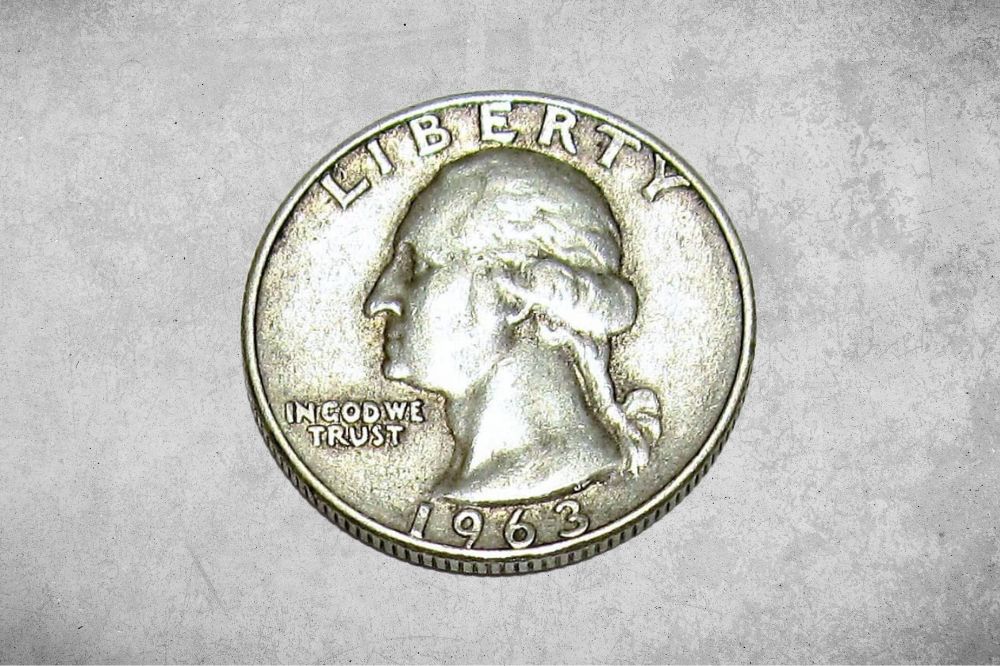Are you in possession of the 1963 Quarter coin and you are wondering what it’s worth? If yes, then, you must know that your 1963 quarter coin can come through for you on rainy days. That’s because this coin has a particular amount of silver which is quite valuable.
Although the 1963 quarter coin is no longer in production, it is still very popular and valuable.
Want to know more about the history and the different varieties of this coin? Then keep up with this piece.
1963 Quarter Details
- Category: Washington Quarter
- Mint: Denver, Philadelphia
- Total mintage: 209,604,184
- Face value: $0.25
- Observed designer: John Flanagan
- Reversed designer: John Flanagan
- Edge: Reeded
- Shape: Round
- Diameter: 24.3mm
- Thickness: 1.75 mm
- Composition: 90% Silver, 10% Copper
- Silver weight: 5.625 grams
- Total weight: 6.25grams
Also Read: Top 16 Most Valuable Modern Quarters Worth Money
1963 Quarter Value Chart
| Mint mark | Good | Fine | Extremely fine | Uncirculated |
| 1963 D | $3.78 | $3.78 | $3.78 | $4.82 |
| 1963 P | $3.78 | $3.78 | $3.78 | $4.82 |
1963 Quarter Values and Varieties Guides
1963 D Washington Quarter
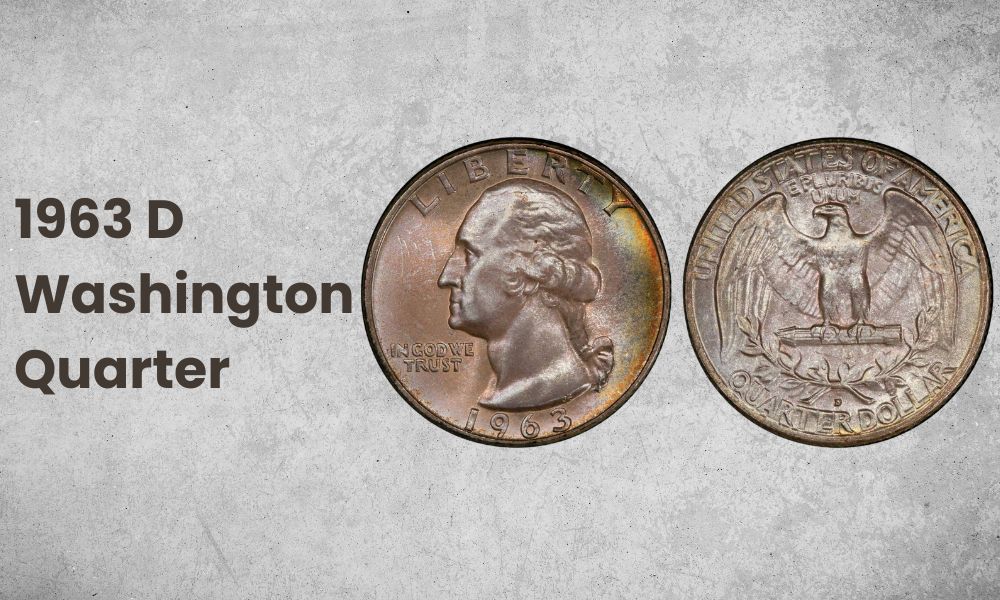
- Type: Washington Quarter
- Edge: Reeded
- Mint Mark: D
- Place of Minting: Denver
- Year of Minting: 1963
- Face Value: $0.25
- $ Price: Twenty-five cents to $10 (or more)
- Quantity Produced: 135,288,184
- Designer: John Flanagan
- Thickness: 1.75 millimetres
- Weight: 6.25 grams
- Diameter: 24.3mm
The 1963 D Washington quarter is a 25-cent coin that was minted in Denver and is considered an important piece of American coinage history. This coin is made of 90% silver and 10% copper alloy, which gives it a total weight of 6.25 grams. The obverse of the coin features a bust of George Washington, designed by sculptor John Flanagan, with the inscriptions “LIBERTY” and “IN GOD WE TRUST” above his bust and the date “1963” below it. The reverse of the coin features an eagle and the inscriptions “UNITED STATES OF AMERICA,” “QUARTER DOLLAR,” and “E PLURIBUS UNUM.” The “D” mint mark, indicating that it was produced at the Denver Mint, is located on the reverse to the right of the eagle.
The 1963 D Washington quarter has a diameter of 24.3mm and a thickness of 1.75mm, making it the same size as other Washington quarters produced in that era. It is not considered a rare coin, but its value depends on its condition, rarity, and type of strike (business or proof). Circulated examples are worth a few dollars, while uncirculated and proof specimens can be worth several times more. The value of silver in the coin also affects its worth.
Depending on the quality and condition, you might be able to sell it for $10 or even more. Bottom of Form
1963 P Washington Quarter
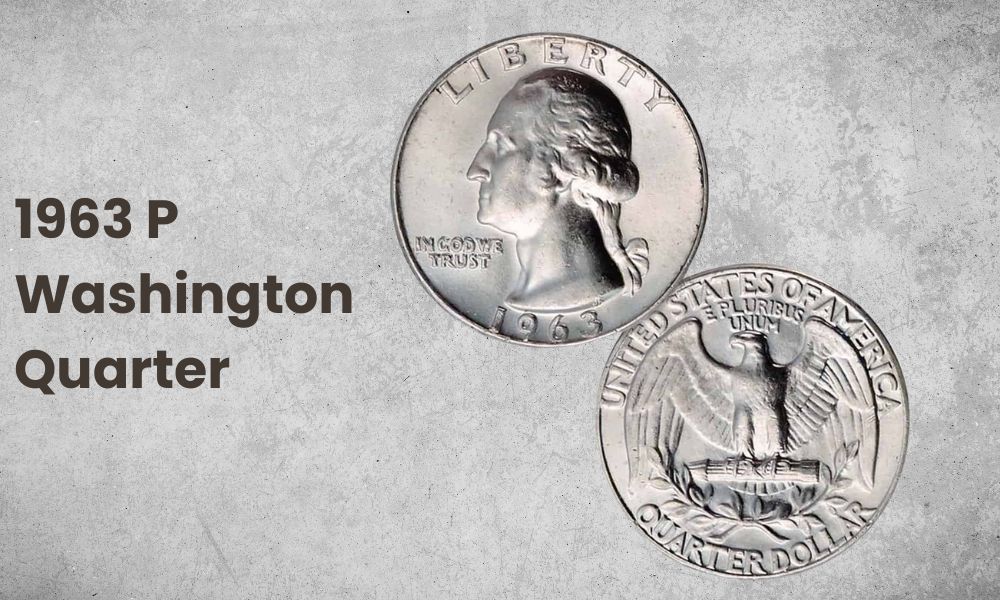
- Type: Washington Quarter
- Edge: Reeded
- Mint Mark: None
- Place of Minting: Philadelphia
- Year of Minting: 1963
- Face Value: $0.25
- $ Price: Twenty-five cents to $10 (or more)
- Quantity Produced: 74,316,000
- Designer: John Flanagan
- Thickness: 1.75 mm
- Weight: 6.3 grams
- Diameter: 24.3mm
The 1963 P Washington quarter is a valuable piece of American coinage history, minted in Philadelphia. It’s made of a 90% silver and 10% copper alloy; and has a total weight of 6.25 grams. On its obverse, the bust of George Washington, designed by sculptor John Flanagan, is depicted with the inscriptions “LIBERTY” and “IN GOD WE TRUST” above it and the date “1963” below. The reverse features an eagle with the inscriptions “UNITED STATES OF AMERICA,” “QUARTER DOLLAR,” and “E PLURIBUS UNUM.”
The Washington quarter produced in 1963 has a diameter of 24.3mm and a thickness of 1.75mm, making it similar in size to other Washington quarters produced during that era. Its worth is influenced by its condition, rarity, and type of strike (business or proof). Although, it is not considered a rare coin; uncirculated and proof specimens can be worth hundreds of dollars
Also Read: Top 15 Most Valuable Quarters In Circulation
History of the 1963 Quarter
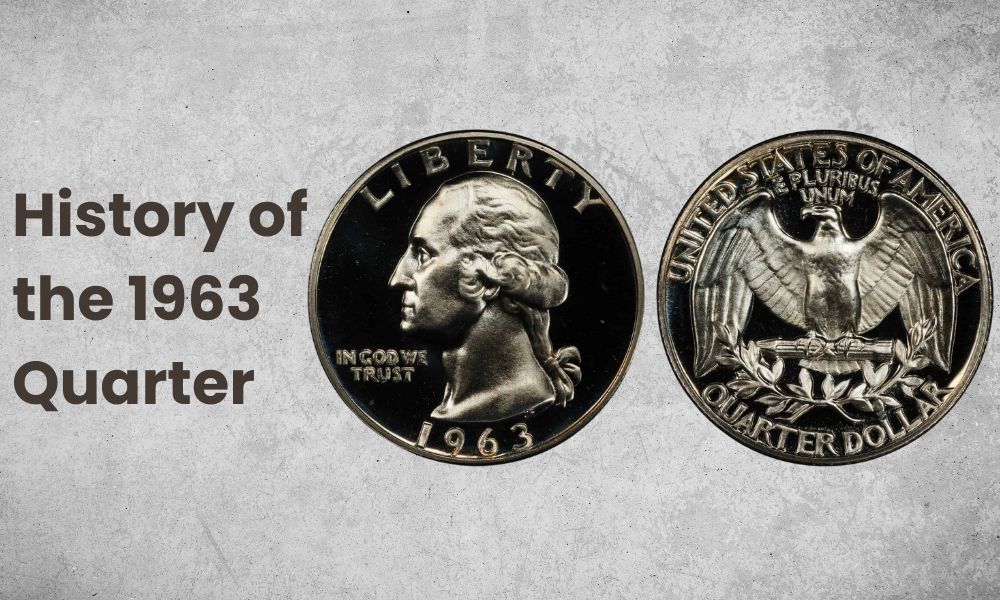
The Washington quarter, also known as the 1963 quarter, has a long history dating back to its introduction in 1932. As part of the celebration of George Washington’s 200th birthday, the design of the quarter was changed and was a departure from the traditional depiction of Lady Liberty that had been featured on the quarters for many years prior. The redesign was a significant event in the history of the coin.
But beyond its historical significance, the 1963 quarter also holds value for coin collectors. Depending on its condition, it can be worth anywhere from a few cents to hundreds of dollars, making it an interesting piece of currency to keep an eye out for!
In terms of value, the 1963 quarter was initially worth only 25 cents, as it was intended to be used as currency in daily transactions. However, as the price of silver rose in the 1960s and 1970s, the value of the 1963 quarter, which is made of 90% silver, also increased. This made the 1963 quarter a popular coin for collectors and investors, and its value has continued to rise over the years.
Today, the value of the 1963 quarter, which is now considered a collectible coin, depends on various factors like its condition, rarity, and mint mark. Circulated examples of the 1963 quarter can range in value from a few cents to a few dollars, whereas uncirculated or proof quarters are worth several times more. Furthermore, special mint mark quarters from facilities like the Denver Mint, due to their rarity, are even more valuable.
Overall, the 1963 quarter is an important piece of American coin history and has maintained its value and popularity with collectors and investors for over half a century. Bottom of Form
Also Read: 10+ Rarest State Quarter Errors Lists (Worth Much Money!!!)
1963 Quarter Grading
The evaluation of a 1963 quarter’s condition, known as grading, plays a crucial role in determining its value. Grading involves assessing the coin’s wear and tear, surface marks, and overall preservation, and then assigning it a numerical grade on a scale of 1 to 70. A coin that receives a grade of 70 is considered to be a perfectly preserved uncirculated coin.
Some of the grades that a 1963 quarter may receive include:
- MS-60 (Mint State 60): A coin in MS-60 grade is in uncirculated condition, but it may have some visible marks or imperfections. The coin may still have its original luster, but there may be some noticeable surface marks or other imperfections that detract from the coin’s overall appearance.
- MS-63 (Mint State 63): A coin in MS-63 grade may have a few more marks or imperfections than a coin in MS-60 grade but it is in uncirculated condition. The coin still retains much of its original luster, but there may be some noticeable surface marks or other imperfections that detract from the coin’s overall appearance.
- MS-65 (Mint State 65): A coin in MS-65 grade is in uncirculated condition and has very few marks or imperfections. The coin retains much of its original luster, and there may be only a few small surface marks or other imperfections that detract from the coin’s overall appearance.
- Proof-70 (Proof 70): A coin in Proof-70 grade is a perfect, uncirculated coin that has been specially struck for collectors. Proof coins are characterized by their mirror-like surfaces and sharply struck designs, and a coin in Proof-70 grade is considered to be of the best condition.
It’s important to note that the grading of a 1963 quarter can be subjective, and different grading companies or appraisers may have slightly different standards. However, a grading certificate from a reputable grading company, such as PCGS or NGC, can provide an independent evaluation of a coin’s condition and help to establish its value.
Check out this video to know the real value of your coin.
1963 Quarter Errors
Like any other coin, the 1963 quarter contains errors and anomalies that can make it more valuable to collectors. Some of the most common errors that can occur in the 1963 quarter include:
1. 1963 “P” Quarter Double Die Obverse (DDO)
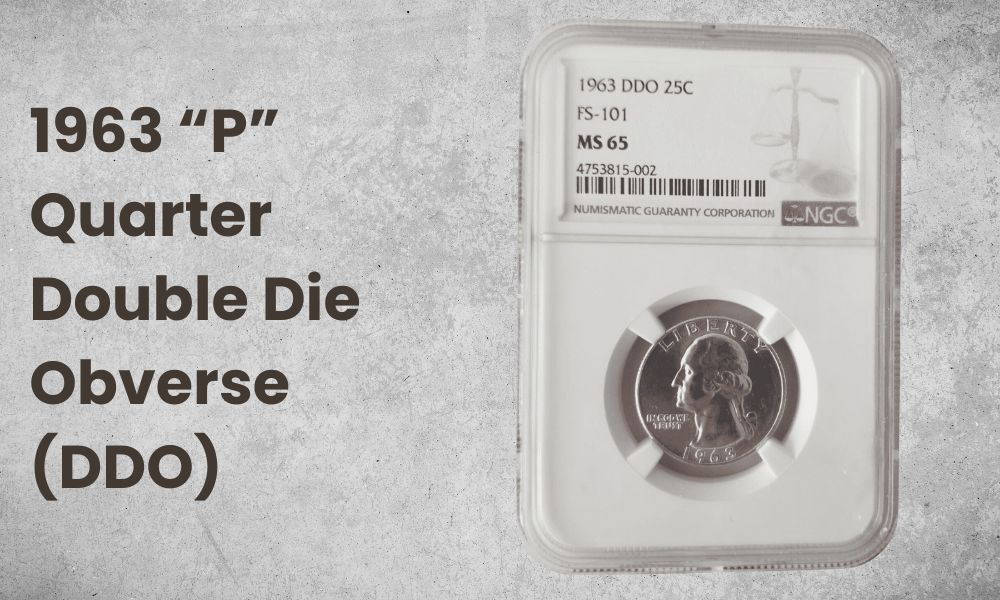
This error occurs when the die shifts in mid-strike, making the second strike land on a slightly different spot. In October 2015, PCGS graded a 1963 quarter MS 67 and it was sold for $999. Also in January 2022, a 1963 quarter with an MS67 rating was sold for $1680. They estimate its 2023 value at $1,100 because they’ve only found one 1963 quarter for grading.
2. 1963 “P” Quarter Double Die Reverse (DDR)
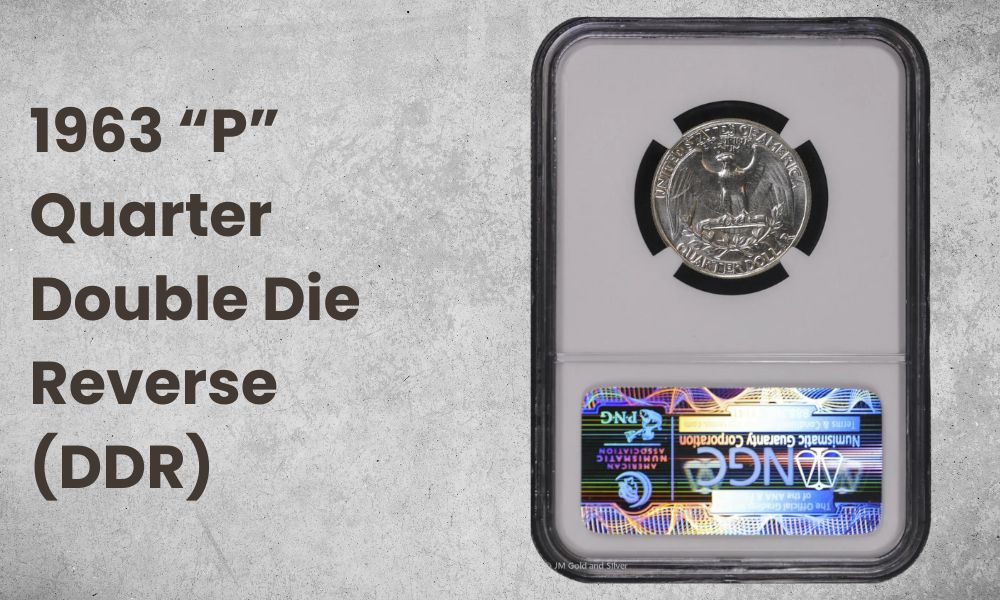
The DDR error is quite similar to the DDO error, just that the doubling takes place on the reverse die. An MS 65 19963 quarter coin was sold for $720 in March 2018. The PCSG has received just one submission of MS66+ which is the highest known grade. Its 2023 value was estimated at $1500. On the other hand, the 1963 quarter with MS 65 rating is estimated at $750 because they’ve only received 8 of the coin for grading.
3. 1963-D Quarter Struck on a Penny Planchet
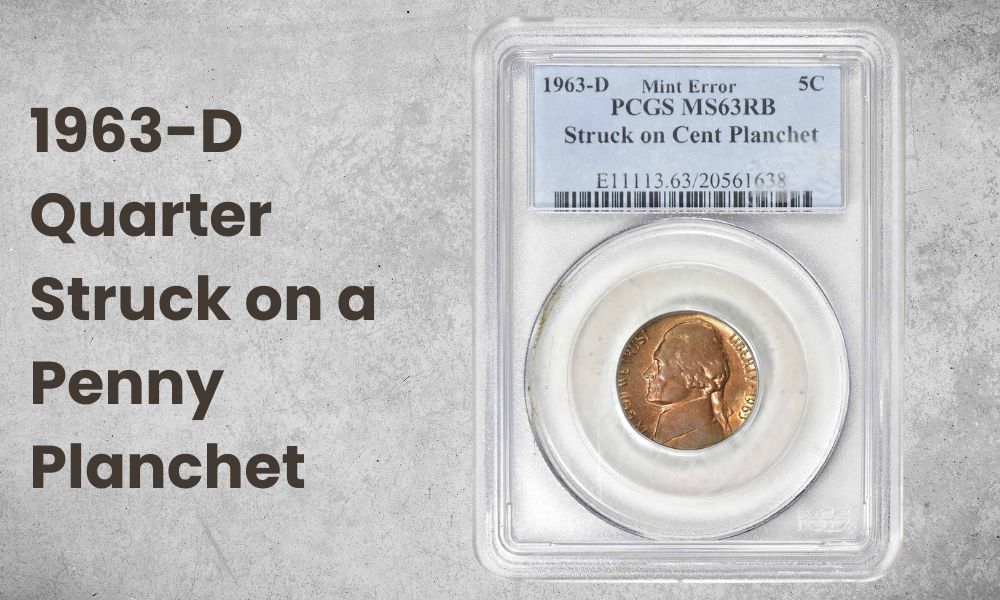
Here, the coin is mistakenly stuck on the wrong planchet which was a blank intended for a penny. The coin has a reddish trademark color which is a result of its copper content. Instead of 6.25g, this coin weighs 3.03g because some of its quarter features have been sliced off. This error coin was valued at $1300.
4. 1963-D Quarter Overstruck Error on a Dime
An overstruck error occurs when a coin strikes another coin that has already gone through the coin press. This error can also be referred to as a Double Denomination Error if only the first coin was an entirely different denomination. This error can be easily noticed because it shows the design of both coins. The rims are truncated because it was overstruck on a 10c coin. The 1963 error coin with MS 62 grading was sold for $2100.
It’s important to note that not all errors on a coin will greatly increase its value. However, if you believe that your 1963 quarter may contain an error, it’s a good idea to have it evaluated by a professional coin appraiser to determine its value.
Check out this video to know more about the 1963 quarter coin error.
FAQs:
1. Why is the 1963 quarter rare?
The 1963 quarter is not considered a rare coin by itself. However, special mint mark quarters from facilities like the Denver Mint are considered more valuable due to their rarity. Notably, the 1963 quarter’s value is determined by a combination of factors, and its rarity or worthiness as a collectible coin can vary.
2. How much is a 1963 quarter worth?
The exact value of a 1963 quarter can range from a few cents to several hundred dollars, depending on its condition and other factors. The value of silver in the coin can also affect its worth. To determine the exact value of a 1963 quarter, it is best to consult a professional coin dealer or a coin grading service.
3. What is the composition of the 1963 quarter?
The 1963 quarter is composed of 90% silver and 10% copper alloy.
4. Who is the man in the 1963 quarter?
The man in the 1963 quarter is George Washington, the first President of the United States. The quarter was designed in honor of the 200th anniversary of Washington’s birth, and the new design was a departure from the traditional depiction of Lady Liberty that had graced the quarters for decades prior.
5. What determines the value of the 1963 quarter coin?
The value of a 1963 quarter is not solely determined by its mintage figures, as other factors such as condition, rarity, type of strike, and the presence of a special mint mark also play a role in determining its worth as a collectible coin.
6. How do I know if my 1963 Quarter Doubled Die or Mechanical DDO?
It might be very difficult to identify the two errors in the 1963 Quarter coin. This is because both errors include doubling. However, a coin grading service provider will help identify the error easily.
Conclusion
One thing you should be certain about before selling or buying more 1963 Quarter coins is their condition. Ensure the coin you have or the one you are about to buy is not a damaged coin because that’ll greatly reduce the value of the coin.
